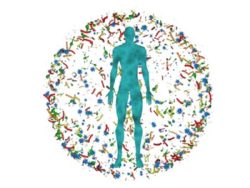Tonsillitis, Ear infections, and Swollen Glands
While working as a pediatrician at Cleveland Clinic, I encountered so many fascinating cases that I kept a diary between August 4, 1975 and May 14, 1976. One of the most interesting was a five year old boy. His mother brought him because of “repeated swollen glands”. The history she reported was that between the ages of 2 and 2 1/2 he had experienced a weight loss of as much as 18 pounds. This was followed by repeated episodes of tonsillitis, ear infections, and swollen glands in the neck, accompanied by fever between 102 and 103°. Of course, they had always been treated with antibiotics as an infection. Each episode would last approximately between seven and nine days, with as little as 3-4 days of freedom between each episode.
There were other disturbing features. He began to sit up at the age of nine months, but was not walking until the age of 14 months and speech had been delayed until 18 months, all symptomatic of developmental delay. He was said to have experienced 12 to 15 “colds“ in the first year, together with recurrent asthmatic bronchitis. He complained constantly of fatigue, feeling unwell and his appetite was extremely poor. He experienced feeling cold in an environment where others were comfortable. Another important feature was that each of these febrile episodes began with him being extremely irritable, vomiting repeatedly and complaining of abdominal pain after food. They were associated with profuse sweating. There was a family history of an adolescent sibling who had died with a diagnosis that implied defective function in the nervous system but the condition was unspecified. A first cousin reportedly had Hodgkin’s disease, a malignancy of lymph glands.
Hospitalizations and Elevated Vitamins B12 and Folate
Over the summer of 1975, the child had been admitted to a hospital three times. During one of these admissions a swollen gland in the neck had been removed for pathological study and the histopathology had been described as “non-specific”. The wound left by the removal of this gland was complicated by the formation of an abscess. Another interesting detail mentioned by the mother was that blood levels for vitamins B12 and folate had been found to be elevated at the hospital where the gland had been biopsied. In fact the doctor had told her that she was giving too many vitamin supplements to her child. Although she had no idea why these blood levels were measured, she told the doctor that she was not giving any vitamin supplements to her child and was extremely puzzled by the information. Of course, her denial was not believed.
The physical examination was extremely important. As would be expected in a constantly sick child, he was pale and had shadows under the eyes. This was the “face of stress”, precisely what Selye had observed when he decided to study how humans become sick from any form of stress, including infection. His pulse was 104 bpm, but there was a rhythmic change in association with breathing which reflected an unusual activity of the autonomic nervous system (ANS). Although the blood pressure was normal for a five-year-old child, the diastolic pressure repeatedly fell to zero, also a reflection of unusual activity of the ANS. The ANS is the automatic nervous system that controls the adaptive actions of body organs under the control mechanisms in the lower part of the brain. This part of the brain is peculiarly sensitive to energy deficiency.
It had presumably been treated as recurrent bacterial or viral infections occurring in a slightly mentally retarded child with an unknown reason for the complete lack of immunity. The question that occurred to me was whether the manifest mental delay, the changes observed in the function of the ANS and the recurrent episodes of swollen glands were in any way related under one causative factor. The report of blood tests to measure the levels of folate and vitamin B12, for whatever reason they had been done, pointed to the suspicion of a metabolic underpinning and I elected to repeat them. To my great surprise, the vitamin B 12 level was unequivocally elevated at 1050 pg/ml (normal 160-900) and the folate was similarly elevated at 29ng/ml (normal 4-18). It was not therefore surprising that the hospital doctor had accused the mother of giving vitamins to her child although the reason for these measurements remained obscure. In addition, he had a history of infancy ear infections and asthmatic bronchitis. In the present medical model, this would mean that he had experienced three or four different disease entities, each with its own cause .
Because even at this stage of my career, I was deeply concerned with energy metabolism as the root cause of disease, I subjected him to a series of tests, the net result of which showed that he was indeed suffering from thiamine deficiency in the brain. I therefore subjected him to a clinical trial with megadose thiamine given by mouth. The effects were remarkable.
Treating Thiamine Deficiency
Between January 21, 1976, when treatment had started, and March 26, 1976 he had experienced one episode of vomiting, slight fever and swollen neck glands. His body weight had increased from 43 pounds to 44 1/4 pounds and his stature had increased from 41 3/4 inches to 42 3/4 inches. This unusual increase in stature is actually evidence of improved functional activity in the ANS. I had observed a similar increase in a 14 year-old boy with autonomic dysfunction. One of the statements made by the mother was that “we can’t wait to get him back to school. He is too peppy.” The vitamin B12 measurement had dropped form 1052 to 740 pg/ml and the folate had dropped from 29 to 12.6 ng/ml, both in the normal range.
I managed to persuade the reluctant mother to stop giving the child the thiamine and he returned on May 12, 1976 with the following story. He had relapsed just about three weeks after the thiamine was withdrawn. The symptoms were recurrent abdominal pain, irritability, return of fatigue, fever and swollen glands in the neck. Physical examination revealed a huge lymph gland in the back of his neck, a smaller one in the front of the neck and there were some swollen glands in the arm pits making me wonder whether the swollen lymph glands of his cousin’s diagnosis of Hodgkin’s disease could have a genetically causative relationship. With reinstatement of thiamine, he completely recovered and remained well.
There is fundamental reasoning behind the decision to attempt a clinical trial with megadose thiamine. First of all, a lab test that was too technical to be described here showed an important relationship with thiamine metabolism. From that, it was easy to draw a conclusion that there would be a degree of energy failure in the brain because thiamine is vital to energy production. To explain the elevation of folate and B12, their activation depends on energy consumption. Lacking energy, we can conclude that they simply accumulated in the blood in their inactive form and when thiamine was provided, the improvement in energy metabolism would enable them to become active. They were then able to do their job instead of accumulating in an inactive state. Like any man-made machine, the body requires energy to be produced. It then uses that energy for its many physical and mental functions.
Reconsidering Fever, Sore Throat and Swollen Glands
The common cause of tonsillitis with fever and swollen neck glands is infection as we all know. But what we have failed to realize is that the presentation that we call an illness is really evidence that the brain has set up a complex of defense against the invading organism. It is an automatic response to an infectious invasion. However, what we know about a mild degree of brain energy deficiency is that it becomes more sensitive to all sensory input. It can therefore start a defensive program, even though there is no attacking microorganism, perhaps reacting to an unknown stress such as a weather change. An infection, identified as a microorganism, is a known stressor, whereas in this child it was a false perception. We do not know why he had developed thiamine deficiency but the family history suggests the possibility of a genetic link. His developmental delay might be explained also by lack of brain energy and this was the underlying solution for lack of development as well as the recurrent episodes. The formation of an abscess in a surgical wound when a gland was removed for biopsy demonstrated a complete lack of immune defense. We know that the immune mechanism is controlled through the nervous system via the spleen and it also requires energy. Finally, his rapid growth and mental development after receiving thiamine demonstrated that there was sufficient energy for “catch up” growth, additional evidence of improvement in energy metabolism.
We Need Your Help
More people than ever are reading Hormones Matter, a testament to the need for independent voices in health and medicine. We are not funded and accept limited advertising. Unlike many health sites, we don’t force you to purchase a subscription. We believe health information should be open to all. If you read Hormones Matter, like it, please help support it. Contribute now.
Yes, I would like to support Hormones Matter.
Photo by Kelly Sikkema on Unsplash.
This article was posted originally on March 9, 2020.













